This post may contain affiliate links which means I may receive a commission for purchases made through links. I only recommend products that I have personally used. As an Amazon Associate I earn from qualifying purchases. Learn more on my Private Policy page.
Whether you want to add rosemary plants to your outdoor garden or keep them thriving indoors during the winter, this simple propagation method is a game-changer. So, how does one go about propagating rosemary from cuttings?
To grow rosemary from cuttings, cut healthy 4-6″ stems from the plant, remove lower leaves, and shave a thin layer from the stem base to promote root growth. Root the cuttings in water for 4-6 weeks, then transplant them into pots with well-draining soil, provide indirect sunlight, and maintain soil moisture.
Growing rosemary from cuttings can create an endless supply of new plants. This saves you money on new seedlings and ensures a consistent supply of fresh rosemary for culinary use.
Let’s explore some pro tips related to growing rosemary from cuttings in greater detail to ensure successful rosemary propogation.
Table of Contents
See my Complete Guide to Rosemary for a deeper dive into this aromatic herb.
1) Prepare Supplies for Propagating Rosemary Cuttings
Gathering the necessary tools and materials is essential to successfully grow rosemary from cuttings. Ensuring sterility is also crucial to prevent disease.
Gather Essential Tools and Materials
To start propagating rosemary from cuttings, you will need a few key supplies:
- Pruning shears: Ensure they are sharp and clean to avoid damaging the stems.
- Small pots: Choose small-sized pots. They should be able to accommodate the cutting without being too spacious to help maintain moisture levels around the stem.
- Well-draining potting mix: Rosemary prefers well-draining soil to prevent waterlogged roots.
- Rooting hormone (optional): While not essential, rooting hormone can increase the chances of successful root development of herb cuttings.
Ensure Sterility for Disease Prevention
Ensuring your equipment is sterile during propagation is crucial to prevent diseases from affecting your rosemary cuttings.
- Clean tools: Make sure your pruning shears are free from dirt or debris and wipe them down with rubbing alcohol or a disinfectant.
- Sanitize containers: If reusing pots or trays, wash them thoroughly with warm, soapy water and rinse them well before use.
By gathering the necessary tools and materials, ensuring sterility throughout the process, and selecting suitable containers with proper drainage, you will be well-prepared to propagate rosemary from cuttings successfully.
2) Select Healthy Rosemary Stems
To successfully grow rosemary from cuttings, selecting healthy stems is important. Look for strong and vibrant stems, as these will have a higher chance of rooting and thriving.

- Select 4-6″ Stems (10-15 cm): This length provides enough room for rooting while remaining manageable.
- Choose Firm, Green Stems: Avoid any stems that appear wilted or discolored, as they may not be in optimal health.
- Choose Semi-Hardwood Stems: It’s best to choose semi-hardwood over softwood when propagating rosemary from cuttings. Semi-hardwood stems have partially matured wood, which helps promote successful rooting.
- Avoid Stems with Disease or Damage: Check the stems thoroughly for signs of disease, such as fungal infections. Also, inspect the stems for any physical damage like cuts, bruises, or scars. Avoid stems showing any of these types of issues.
You increase the chances of successful propagation by carefully selecting healthy rosemary stems for cuttings and avoiding those with disease or damage. Remember to choose stems of the right size and appearance and are at an appropriate stage of maturity. These factors contribute significantly to the overall success of growing rosemary from cuttings.
While cutting rosemary stems for propagation is similar to harvesting, it is not entirely the same. For more information, read my article on how to harvest rosemary.
3) Cut and Prepare Rosemary Cuttings
To successfully grow rosemary from cuttings, it is important to properly prepare the stems. Start by removing the leaves from the cutting’s lower 2 inches (5 cm). This will create a clean stem that can be inserted into the growing medium without any obstructions. Removing these leaves also helps redirect energy towards root development rather than supporting unnecessary foliage.
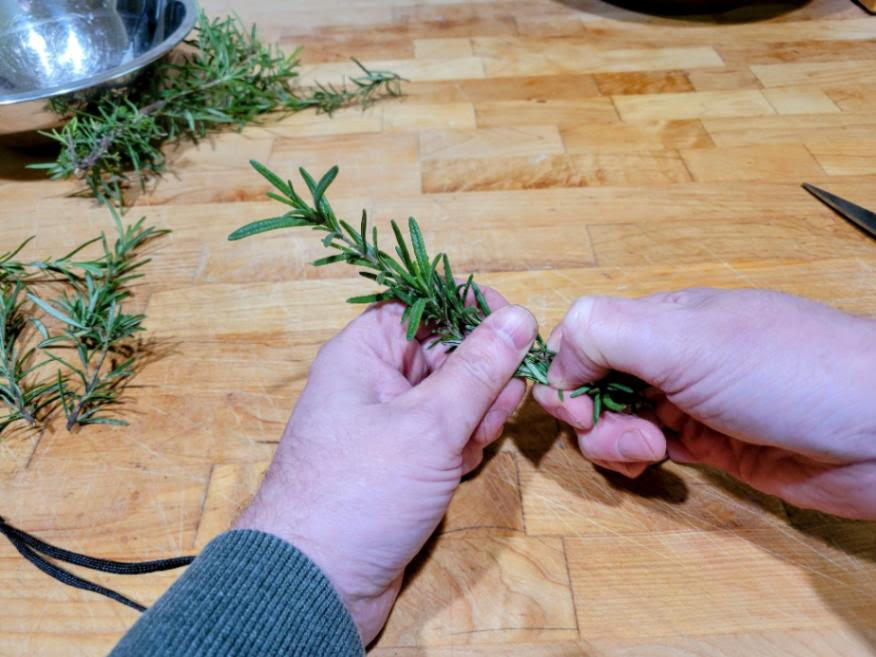
Shave Off the Surface on One Side of the Stem
Next, take a pair of scissors or pruning shears and shave off a thin surface layer on one side of the stem. This process, known as “wounding,” encourages root growth by exposing more cambium tissue. The cambium layer is responsible for producing new cells, including roots. Creating this wound stimulates the plant’s natural response to produce roots in that area.
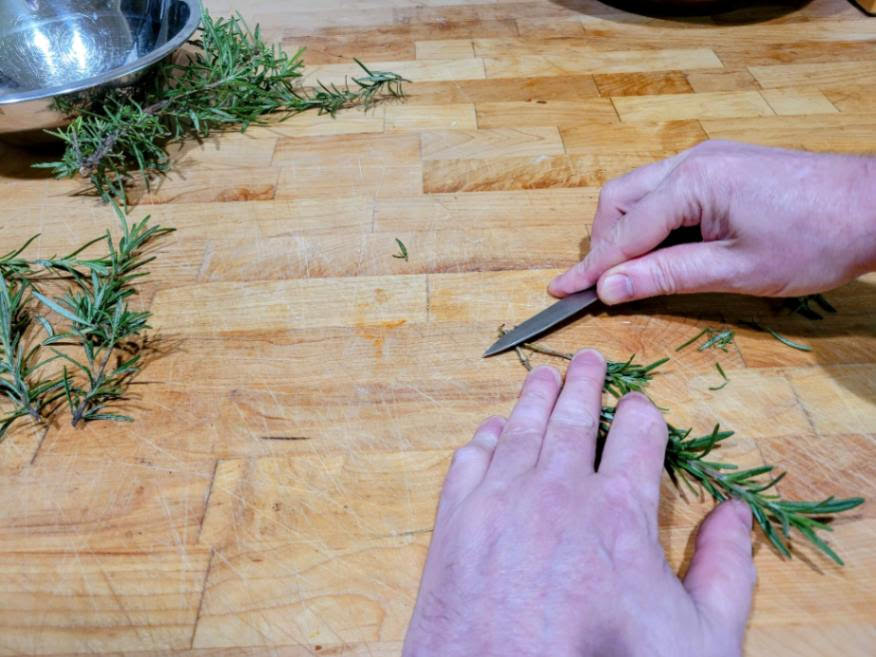
Use Rooting Hormone if Desired
While not necessary, you can use rooting hormone to increase your chances of successful propagation when growing rosemary from cuttings. Rooting hormone contains auxins, which are plant hormones that promote root formation.
It’s worth noting that rosemary is generally quite easy to propagate without rooting hormone. While I’ve found that rooting hormone can help with root formation on other herbs, it’s not necessary with rosemary cuttings.
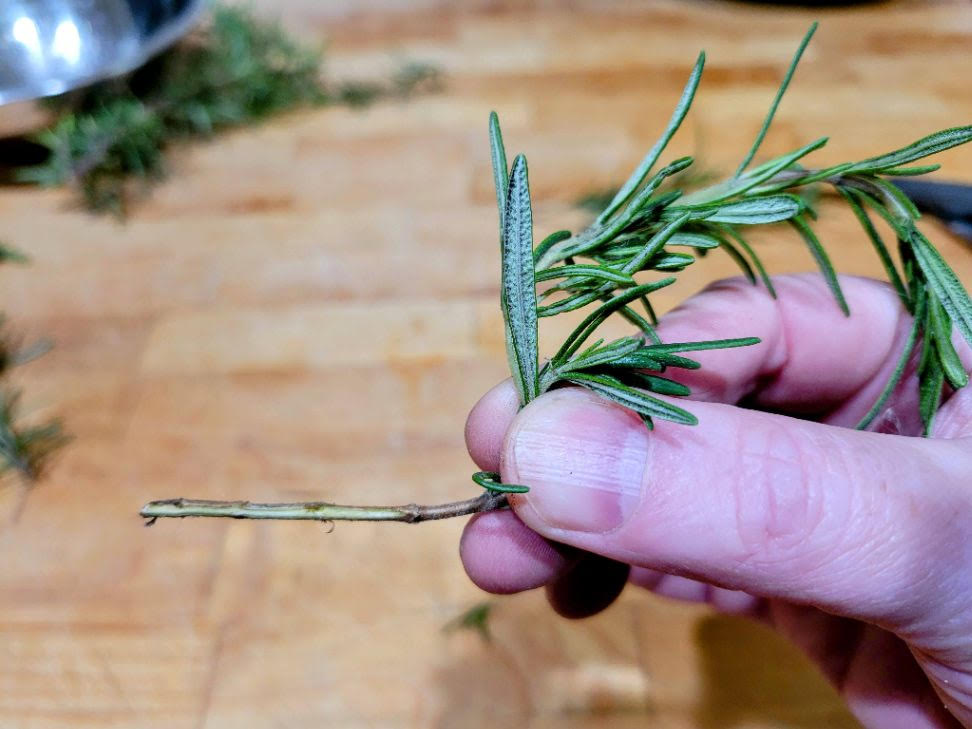
4) Place Rosemary Cuttings in Water to Root
While this step is optional, I would definitely recommend it, as rooting your rosemary stems in water will garner more success than rooting directly in a planting mix.
Submerge Rosemary Cuttings in Water
To grow rosemary from cuttings, the first method involves placing the cuttings in water to encourage root growth. Fill a glass or jar with fresh water and submerge the cut end of the stem into it.
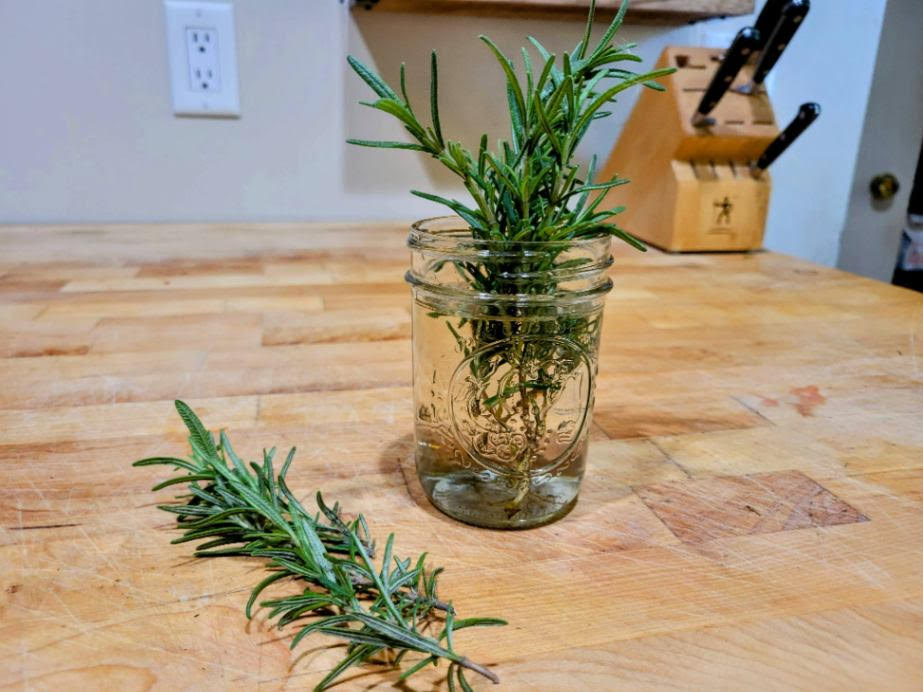
Refresh Water Regularly
It is crucial to maintain the freshness of the water when rooting rosemary cuttings. Every few days, replace the water with fresh, room-temperature water to prevent bacterial growth and provide adequate oxygen for root development.
Monitor Rosemary Root Growth
As you wait for roots to develop, watch your rosemary cuttings closely. Look for small white roots emerging from the nodes submerged in water. It will probably take 4-6 weeks before significant root growth occurs.
Transplant Rosemary at 1-Inch Root Length
Once your rosemary cuttings have developed approximately one-inch long roots, they can be transplanted into soil. Gently remove them from the container with water and carefully transfer them into pots filled with well-draining soil mix. Bury each cutting deep enough so that only a few inches of stem remain above the growing medium’s surface.
5) Plant Cuttings in Potting Mix
Whether or not you’ve chosen to root your cuttings in water, you’ll eventually need to plant your rosemary cuttings into a growing medium.
Choose small-sized pots that provide enough space for the new roots to develop. Fill the pots with a well-draining potting mix to provide the necessary nutrients and moisture for the cuttings to thrive.
If you’ve opted not to root your rosemary cuttings in water, firmly press your rosemary cuttings into the growing medium right up to the point where you’ve stripped the leaves from the stem.
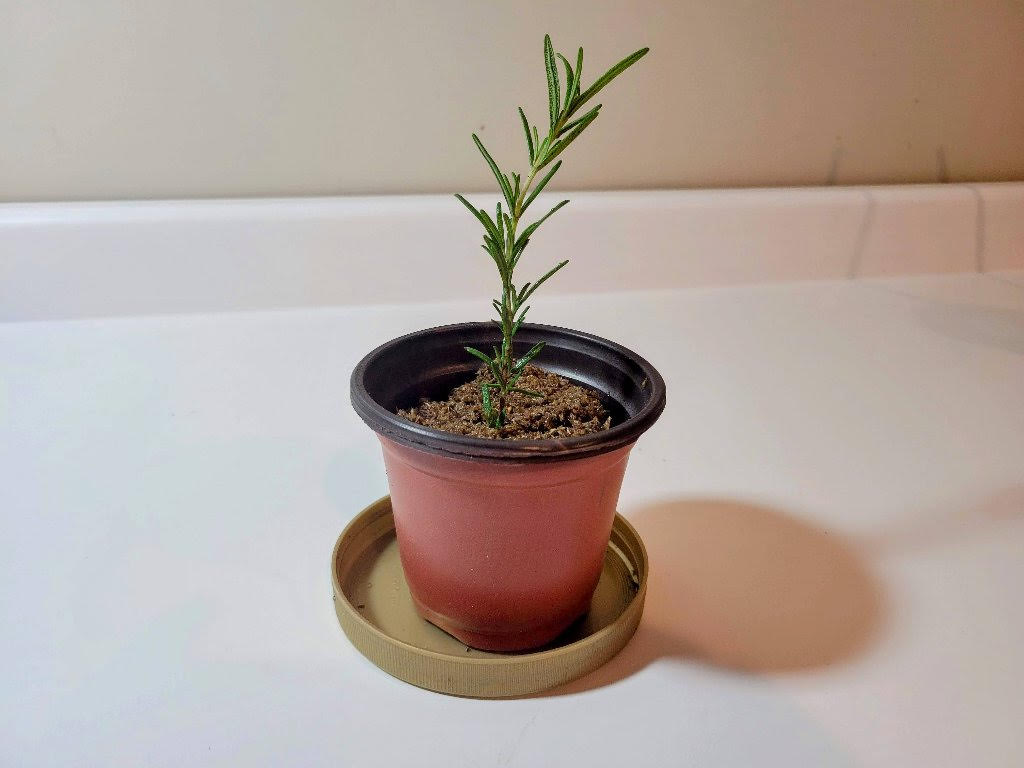
If you’ve rooted your stems in water, dig a hole by pressing your finger or a pencil into the growing medium. Gently place the rooted rosemary stem into the hole up to where the leaves are coming from the stem. Next, carefully fill the hole with growing medium
After planting your rosemary cuttings, give them a light watering to settle them into their new environment. Be careful not to overwater at this stage, as excessive moisture can lead to the rotting of the stems before they have a chance to develop.
It is important to maintain consistent moisture levels without saturating the soil. Check regularly by inserting your finger about an inch into the growing medium; if it feels dry, water lightly until moisture is evenly distributed throughout.
Additional Tips for Success
- Place your potted rosemary cuttings in an area with bright but indirect sunlight.
- Maintain temperatures between 65°F and 75°F (18°C and 24°C) for optimal growth.
- Consider misting your cuttings periodically with water to increase humidity levels around them.
By following these steps and providing the right conditions, you can successfully grow rosemary from cuttings and enjoy the benefits of this aromatic herb in your kitchen garden or landscape.
6) Transplant Cuttings to Larger Containers
After your rosemary cuttings have established roots, it’s time to transplant them into larger containers.
Select Adequate Containers
Choose containers that are large enough to accommodate the growing root system of your rosemary plant. Opt for pots or containers at least 6-8 inches deep with drainage holes at the bottom. This will prevent waterlogging and ensure proper aeration for the roots.
Handle Rosemary Delicately to Not Damage Roots
When removing the rooted cuttings from their initial container, handle them delicately to avoid damaging the fragile roots. Gently loosen the soil around the base of each cutting before carefully lifting it out. Be mindful not to tug or pull forcefully, as this can cause harm to the delicate root system.
Repot with Fresh Mix
Prepare a fresh potting mix specifically formulated for herbs or use a well-draining mix. Fill each new container about halfway with this fresh mix, creating a suitable environment for your transplanted rosemary cuttings.
Carefully place each cutting into its new container, making sure that it sits upright and its roots are fully covered by soil. Add more potting mix around the cutting until it reaches just below the level where leaves emerge from the stem.
For more information about the best growing medium to use for indoor herbs, read my article on What is the Best Soil for Indoor Herbs.
Provide Adequate Watering
Water your newly transplanted rosemary cuttings gently but thoroughly after repotting them. Ensure that water reaches all areas of the container without causing excessive saturation. Aim for evenly moist soil rather than soggy conditions that could lead to root rot.
Encourage Growth with Proper Care
To promote healthy growth in your transplanted rosemary cuttings, provide them with the right conditions. Place the containers in a sunny location where they can receive at least 6-8 hours of direct sunlight every day. Rosemary thrives in warm temperatures, so ensure the plants are kept in a suitable environment.
Monitor the moisture levels of the soil regularly and water when it feels slightly dry to the touch. Avoid overwatering, as rosemary prefers drier conditions and can suffer from root rot if left sitting in waterlogged soil.
Conclusion
Growing rosemary from cuttings is a rewarding and fairly straightforward process. Following the steps outlined above, you can successfully propagate rosemary from cutting at home.
If you’re looking to add fresh rosemary to your culinary creations or enhance your garden with its beautiful foliage and fragrance, don’t hesitate to try propagating it from cuttings. With a little patience and care, you’ll have an abundant supply of this versatile herb at your fingertips.
Frequently Asked Questions (FAQs)
How long does it take for rosemary cuttings to root?
Rosemary cuttings typically take around 4-6 weeks to develop an adequate root supply when placed in water. Keep in mind that individual results may vary depending on factors such as temperature and humidity.
Can I use rooting hormone when propagating rosemary?
While rosemary roots fairly easily and don’t require rooting hormone, using it can increase the chances of successful root development when propagating rosemary from cuttings. It helps stimulate root growth and can be especially beneficial if you’re experiencing difficulties with rooting.
How often should I water my rosemary cuttings?
It’s important to keep the soil or water moist but not overly saturated when caring for rosemary cuttings. Aim to water them whenever the top inch of soil feels dry or if they are planted in water, change it every few days to prevent stagnation.
Can I plant multiple rosemary cuttings together?
You can plant multiple rosemary cuttings together in larger containers once they have developed roots. This allows them to grow in close proximity and creates a fuller, bushier appearance. Make sure not to crowd them too closely as you don’t want your plants competing for resources.
When is the best time to take rosemary cuttings?
The best time to take rosemary cuttings is during the spring or early summer when the plant is actively growing. This ensures that the stems are healthy and have a higher chance of successfully rooting.
Last Updated on 25 October 2023 by Bob Lee

